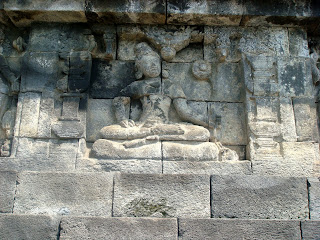Wednesday
d' Day...my day. A special day. I left the four corners of my school to go on a road trip to Borobudur. It was quite a long drive from Jogja, about 35 kilometers away or more from where i stayed.

It’s a very humid day giving me a bit of a migraine. As i sit in front of the kijang we rented and see parts of the province as we drove by, i tried to recall my first memory of Borobudur from a picture in my elementary history class. I'll never forget when i wished to myself that I'd visit it one day. Borobudur is on my list of places to visit. It's nothing fancy and modern but i knew in my heart it was worth visiting.
I dreamed of this day since I was twelve. It was scorching hot and i could feel the sun burning me but it didn't matter. I was just happy to see, touch and kiss this place as i have imagined it a long, long time ago.

Upon reaching the gates, we got ourselves a guide to explain, particularly to me about the brief history and legend of this famed Buddhist temple.
Setting the backdrop of Borobudur is a chain of hills and mountains. If not for our guide, i wouldn't know that the shape of the mountain on the west side was of a reclining man. According to the legend, a very strong and powerful man named Gunadarma, built the temple. When he got old, he just went nearby the temple and slept and died there.

Taking note of its technical, architectural and symbolic structure, Borobudur is closely related to the other Buddhist temples in Cambodia and India. Our guide further said that though modern measuring, drilling techniques, aerial photography have helped to reveal much which until a few years ago was unknown, nevertheless a considerable amount of ignorance, speculation and mystification remains. Neither the exact date of construction nor the name of the ruler who ordered it is known.
I felt genuinely sad about this.


Borobudur consists of nine superimposed terraces, symbolizing the nine levels of the Holy Mount Meru. All these levels represent the spiritual phases of existence. The first lower levels Kamadhatu symbolizes the transitoriness of life; where mortals still embrace earthly desires.The slightly upper levels represents Rupadhatu, where the followers renounce all human desires. While the highest level represents Nirvana or Eternal Deliverance.
The walls of the temple is adorned by frames of reliefs and stupas. These images were said to have been carved painstakingly by followers depicting the life of Siddharta Gautama - the founder of Buddhism, who was born in 560 B.C. and the legend of Gautama’s mother: Queen Maya. The Stupas surrounding the temple resembling like a bell are actually abstractions of a lotus blossom, again symbolizing Holy Mt. Meru.

As I survey from the top, I thought of taking in the experience one more time. I went around and took pictures and touched the details one last time, reminding myself that I may not see Borobudur again.

I bid farewell to Borobudur and thanked God for the chance to see it on a special day: my d’ Day.
Thank you for reading.

















No comments:
Post a Comment